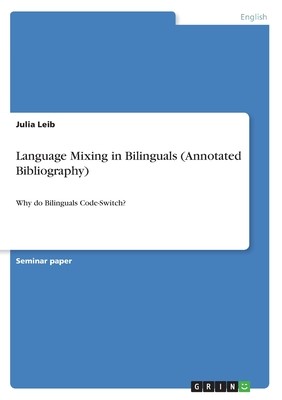
- We will send in 10–14 business days.
- Author: Julia Leib
- Publisher: GRIN Verlag
- Year: 2011
- Pages: 20
- ISBN-10: 3640909127
- ISBN-13: 9783640909124
- Format: 14.8 x 21 x 0.1 cm, softcover
- Language: English
- SAVE -10% with code: EXTRA
Language Mixing in Bilinguals (Annotated Bibliography) (e-book) (used book) | bookbook.eu
Reviews
Description
Seminar paper from the year 2010 in the subject English Language and Literature Studies - Linguistics, grade: 1,0, University of Frankfurt (Main) (Institut für England- und Amerikastudien), course: Bilingualismus, language: English, abstract: In today's globalized world bilingualism, defined as the regular use of two or more languages, is a widespread phenomenon and has become nearly the standard and monolingualism the exception. Consequently linguists have become more and more interested in this topic and in the last decades much has been published regarding bilinguals and their language behavior. Being able to manage two different languages or dialects, bilinguals are capable to code-switch within their languages. Code-Switching (in the following referred to as CS) occurs when a word or a phrase in one language substitutes for a word or phrase in a second language. "Code switching is the alternate use of two (or more) languages within the same utterance, as illustrated in (1) (Belazi, Rubin, and Toribio, 1994). (1a) This morning mi hermano y yo fuimos a comprar some milk. This morning my brother and I went to buy some milk. (1b) The student brought the homework para la profesora. The student brought the homework for the teacher." CS follows functional and grammatical principles and is a complex, rule-governed phenomenon. Bilingual speakers often code-switch from one language to another, especially when both languages are used in the environment. This is mostly the case in multilingual communities. Although much has already been written on how bilinguals organize their two languages, little is known about why bilinguals mix their two languages during communicative process. It would be easier for them just to stay in one language while communicating, being understood by everyone. Nevertheless they switch codes during conversations. This raises the question: Why do bilinguals code-switch? The aim of this annotated bibliography is to shed some
EXTRA 10 % discount with code: EXTRA
The promotion ends in 20d.19:34:50
The discount code is valid when purchasing from 10 €. Discounts do not stack.
- Author: Julia Leib
- Publisher: GRIN Verlag
- Year: 2011
- Pages: 20
- ISBN-10: 3640909127
- ISBN-13: 9783640909124
- Format: 14.8 x 21 x 0.1 cm, softcover
- Language: English English
Seminar paper from the year 2010 in the subject English Language and Literature Studies - Linguistics, grade: 1,0, University of Frankfurt (Main) (Institut für England- und Amerikastudien), course: Bilingualismus, language: English, abstract: In today's globalized world bilingualism, defined as the regular use of two or more languages, is a widespread phenomenon and has become nearly the standard and monolingualism the exception. Consequently linguists have become more and more interested in this topic and in the last decades much has been published regarding bilinguals and their language behavior. Being able to manage two different languages or dialects, bilinguals are capable to code-switch within their languages. Code-Switching (in the following referred to as CS) occurs when a word or a phrase in one language substitutes for a word or phrase in a second language. "Code switching is the alternate use of two (or more) languages within the same utterance, as illustrated in (1) (Belazi, Rubin, and Toribio, 1994). (1a) This morning mi hermano y yo fuimos a comprar some milk. This morning my brother and I went to buy some milk. (1b) The student brought the homework para la profesora. The student brought the homework for the teacher." CS follows functional and grammatical principles and is a complex, rule-governed phenomenon. Bilingual speakers often code-switch from one language to another, especially when both languages are used in the environment. This is mostly the case in multilingual communities. Although much has already been written on how bilinguals organize their two languages, little is known about why bilinguals mix their two languages during communicative process. It would be easier for them just to stay in one language while communicating, being understood by everyone. Nevertheless they switch codes during conversations. This raises the question: Why do bilinguals code-switch? The aim of this annotated bibliography is to shed some


Reviews